
- 256 pages
- English
- ePUB (mobile friendly)
- Available on iOS & Android
eBook - ePub
About this book
For every artist who longs to capture the beauty of nature on paper, here is clear, concise instruction on creating true-to-life drawings. Author Frank Lohan, an experienced teacher, stresses perceptive study and analysis. His numerous examples illustrate how to discover the underlying geometric shapes of natural subjects, and they show how to develop sketches that form the basis of realistic compositions.
Beginning and advanced artists as well as wildlife enthusiasts will appreciate these 600 images of birds, flowers, trees, animals, reptiles, and amphibians. Step-by-step methods, explained in simple terms, offer guidance on selecting tools and materials; creating perspective drawings; employing pencil, pen, and charcoal techniques; and other approaches.
Beginning and advanced artists as well as wildlife enthusiasts will appreciate these 600 images of birds, flowers, trees, animals, reptiles, and amphibians. Step-by-step methods, explained in simple terms, offer guidance on selecting tools and materials; creating perspective drawings; employing pencil, pen, and charcoal techniques; and other approaches.
Frequently asked questions
Yes, you can cancel anytime from the Subscription tab in your account settings on the Perlego website. Your subscription will stay active until the end of your current billing period. Learn how to cancel your subscription.
No, books cannot be downloaded as external files, such as PDFs, for use outside of Perlego. However, you can download books within the Perlego app for offline reading on mobile or tablet. Learn more here.
Perlego offers two plans: Essential and Complete
- Essential is ideal for learners and professionals who enjoy exploring a wide range of subjects. Access the Essential Library with 800,000+ trusted titles and best-sellers across business, personal growth, and the humanities. Includes unlimited reading time and Standard Read Aloud voice.
- Complete: Perfect for advanced learners and researchers needing full, unrestricted access. Unlock 1.4M+ books across hundreds of subjects, including academic and specialized titles. The Complete Plan also includes advanced features like Premium Read Aloud and Research Assistant.
We are an online textbook subscription service, where you can get access to an entire online library for less than the price of a single book per month. With over 1 million books across 1000+ topics, we’ve got you covered! Learn more here.
Look out for the read-aloud symbol on your next book to see if you can listen to it. The read-aloud tool reads text aloud for you, highlighting the text as it is being read. You can pause it, speed it up and slow it down. Learn more here.
Yes! You can use the Perlego app on both iOS or Android devices to read anytime, anywhere — even offline. Perfect for commutes or when you’re on the go.
Please note we cannot support devices running on iOS 13 and Android 7 or earlier. Learn more about using the app.
Please note we cannot support devices running on iOS 13 and Android 7 or earlier. Learn more about using the app.
Yes, you can access Wildlife Sketching by Frank J. Lohan in PDF and/or ePUB format, as well as other popular books in Art & Art Techniques. We have over one million books available in our catalogue for you to explore.
Information
Topic
ArtSubtopic
Art Techniques1
Tools and Materials
Pencil Drawing
Pen Drawing
Paper
Pencil Drawing
The tools needed for pencil. drawing are inexpensive and readily available in any art supply store. Pencils, two kinds of erasers, an erasing shield, paper towel, and fixative to eliminate smudging are all you need for many hours of drawing.
Pencils
There are dozens of kinds of pencils available for sketching. The pencil illustrations in this book were done using only graphite pencils in hardness grades 2H, HB, 3B, and 6B (fig. 1-1). The H series is hard, while the B series is soft. The larger the H number, the harder the lead is. The larger the B number, the softer the lead is. Using a 6H pencil can be like drawing with a nail—it makes a light line and usually leaves an indentation in the paper.
I do not recommend the common No. 2 writing pencil as there is no telling just how hard or soft any brand might be. It is best to buy four drawing pencils, all from the same brand, in the 2H, HB, 3B, and 6B grades. This will give you a completely adequate tonal range for the subjects treated in this book.
Sharpen your pencils with a pen knife or single-edge razor blade or a utility knife. Leave about one-quarter inch of lead beyond the wood (fig.1-3). Then, using a small piece of sandpaper (fig. 1-2), put a slanted, flat surface on the lead. This gives you a broad, flat surface so that you can cover larger areas with a uniform tone, and also gives you a very sharp edge at the tip for putting details in place. I glue a small piece of sandpaper in the cover of a small box, and also glue a piece of paper towel there. This keeps the graphite dust in the box and off my drawing, and gives me a towel to wipe the lead on each time I sharpen it.
Erasers
I recommend two different erasers: one is a soft, pink or white pencil eraser (fig. 1-4), and the other is a kneaded eraser (fig. 1-5). The eraser on the back of a common writing pencil is much too abrasive for use in sketching; it destroys the paper surface.
I’m sure you are familiar with the pink or white pencil eraser, but you may not have seen a kneaded eraser before. It comes in a small rectangular package. Tear about one third of the eraser off—it is like dry chewing gum and tears easily. You can squeeze it together with your fingers, twist it, fold it; press it together again and it becomes one piece. You can pinch it to a sharp edge and press that edge on a dark area of your sketch, or press a larger part of it on your drawing. You will get results like those illustrated in figure 1-6. It is great for slightly lightening a dark area. As you use it, keep kneading the dirty part inside and it will last a surprisingly long time.

Figure 1-1
Sketching pencils.
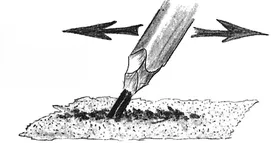
Figure 1-2
Using sandpaper to properly point up the pencil.
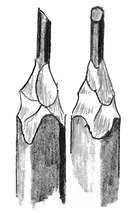
Figure 1-3
Properly sharpened pencils.

Figure 1-4
Pencil eraser.
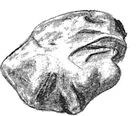
Figure 1-5
Kneaded eraser.
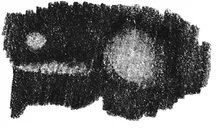
Figure 1-6
Pressing kneaded eraser on drawing produces lightened areas.
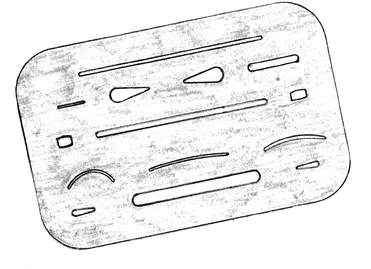
Figure 1-7
Erasing shield.

Figure 1-8
Using eraser shield and pencil eraser makes sharp lines.
Erasing Shield
An erasing shield is a very handy drafting tool (fig. 1-7). It is a thin piece of stainless steel with variously shaped cutouts. You lay it on your drawing to protect areas you do not want to touch, and to expose what you want to erase. You then use the pencil eraser to trim an edge or to erase in the middle of a toned area, as illustrated in figure 1-8.
Paper Towel
I use a folded paper towel like a paint brush to dust the eraser residue from my drawing.
Fixative
I use clear spray enamel to fix or protect my finished drawings after I have cleaned up any smudges. Three or four light coats leaves an invisible, clean surface that greatly reduces smudging from handling or storage.
Two other pencil-like tools illustrated later are the lithographic crayon and the charcoal pencil. Both of these produce intense darks. The lithographic crayon leaves a waxy black residue that smears rather easily but works well with pen and ink. It is usually used on a highly textured paper such as coquille paper to produce a dotted gray background or shading tone very quickly. I use four or five layers of clear spray enamel over the drawings made with lithographic crayon. The use of this crayon with pen and ink is demonstrated in the section on sketching songbirds.
The charcoal pencil in the 4B or 6B grade also produces an intense black quickly. The dust residue may be blown off the drawing and details put in with pen. Charcoal pencil is suitable only on a coarser, toothy paper with grain enough to “hold” the charcoal. It, too, requires three or four coats of the fixative to keep it from rubbing off or smudging other areas.
Pen Drawing
The tools required for drawing with pen are widely available and vary in cost. What you spend depends entirely on your personal preferences. I use all three pens described below in my classes....
Table of contents
- Title Page
- Copyright Page
- Dedication
- Table of Contents
- Introduction
- 1 - Tools and Materials
- 2 - Drawing Techniques
- 3 - Perspective Drawing
- 4 - Songbirds
- 5 - Trees
- 6 - Animals
- 7 - Flowers
- 8 - Mushrooms
- 9 - Water Birds
- 10 - Reptiles and Amphibians
- In Summary
- Bibliography
- Index